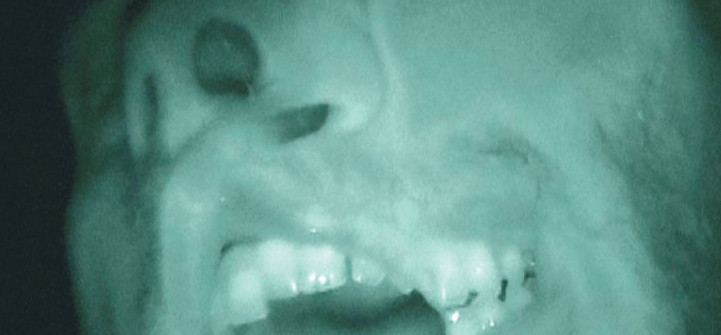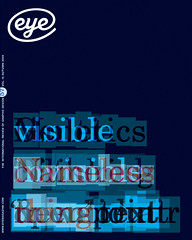Autumn 2005
Expert flesh creepers
Chris Cunningham’s new film is a stomach-churning diversion from our digitally finessed world. Critique by Rick Poynor

Chris Cunningham is one of the UK’s most notable short film makers. His nightmarish Come to Daddy video for Aphex Twin was recently voted the third best music video ever in a poll of directors and industry-insiders. Cunningham’s work is highly regarded in design circles. All is Full of Love, his lyrical video for Björk with the robot lovers, won a rarely awarded D&AD gold and his Directors Label compilation sells in design shops such as Magma.
Cunningham’s latest project, Rubber Johnny, released by Warp, is a personal film rather than a music video, though the soundtrack is again by Aphex Twin. The six-minute DVD comes with a 42-page book of Cunningham’s photographs and drawings. Like all his most striking pieces, the film – shot on infrared digital video – has an intense physicality. Cunningham’s work is closely related to the revival of the horror film in both the Far East and the US, and the same fascination with bodily distortion and traumas of the flesh seems to draw people to his videos.
The promotional material describes Rubber Johnny as a ‘hyperactive, shape-shifting mutant child’ and this is more than a little euphemistic. Johnny, played by Cunningham himself, is severely disabled. He cannot speak and spends his time sitting naked in a wheelchair shut in a darkened basement, with only a terrified Chihuahua for companion. His body arches painfully under the weight of his huge, distended head and his arms clutch at the sides of the chair. We first see his face in blurry close-up, perhaps when he was a baby, as his father asks him off camera in a gentle but ironically detached voice how he is feeling, whether he wants a glass of water or his mama, and what he can see. ‘We’re not really getting anywhere are we?’ he says, before administering an injection to calm Johnny as the boy thrashes around in mounting panic.
Once he is alone, a different Johnny emerges – a rubber-limbed, wheelchair-bound, dance-floor virtuoso. Johnny makes sounds with his mouth like an awakening robot and this rapidly develops into a taut, angular, electronic music of bleeps, pings, squelches, elastic snaps and slapping beats. His extreme disability forgotten, Johnny spins in his chair, rocks back on the wheels and zooms ecstatically around his prison, making vigorous hand gestures and striking poses. Beams of light shoot around him and Cunningham cuts the whole thing at an incredible speed, each edit synchronised with the sound in a way that is viscerally gripping and humorous, too. Some of these effects are achieved by experimental animation and at times Johnny almost disappears in a windmill of whirling limbs.
Is Rubber Johnny trying to say something about the way we underestimate and marginalise the disabled? The subject is often in the news. Marc Quinn’s marble sculpture of an armless pregnant woman will be installed on a plinth in Trafalgar Square in the autumn, in the heart of tourist London. Cunningham’s film comes from somewhere less socially conscious. He seems more preoccupied with anatomy, atmospheric nuance and the technical difficulty of animating a flesh-and-blood figure. In some of the film’s most jarring moments, we see Johnny’s face in close-up as a squishy mess of teeth, gums and disintegrating skin. If this recalls the grotesquely distorted faces in Francis Bacon’s paintings, many of the photographs in the DVD book, including the cover, are like digital realisations of the interpenetrating body parts in the German surrealist Hans Bellmer’s notorious oeuvre: an obscene fusion of testicles, buttocks, mouths and labia. It’s a long way from being politically correct.
Cunningham is one of those film-makers with a gift for surreal and disturbing imagery who barely seems to know where these visions come from. He dredges up images of dark fantasy so perfectly formed and convincing that they cannot be shrugged off: the running man whose limbs shatter like china; the creepy girl with a balloon-sized head lecturing us about ‘mental wealth’ for Sony; the naked man and woman fighting and fucking in the depths of space in Flex; the marauding girls with the bearded heads of musician Richard D. James, and the emaciated monster screaming at the elderly lady, in Come to Daddy.
What we experience in the director’s work, as in so many horror films, is the violent return of the repressed – of everything we kidded ourselves we could avoid or deny in our artificially enhanced, digitally finessed world. Making full use of the most sophisticated technical resources, Cunningham rehumanises digital media by reminding us, sometimes with stomach-churning shocks, of the fragile, mortal envelopes of flesh we still inhabit.
Rick Poynor, writer, Eye founder, London
First published in Eye no. 57 vol. 15 2005
Eye is the world’s most beautiful and collectable graphic design journal, published quarterly for professional designers, students and anyone interested in critical, informed writing about graphic design and visual culture. It is available from all good design bookshops and online at the Eye shop, where you can buy subscriptions, back issues and single copies of the latest issue.

